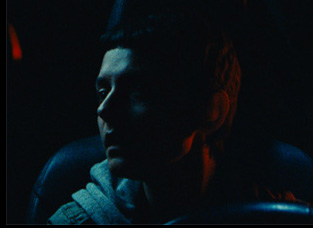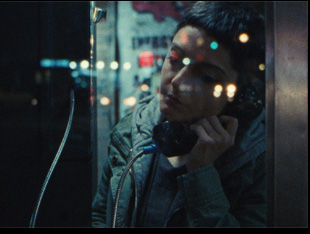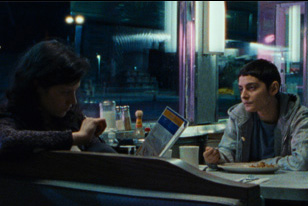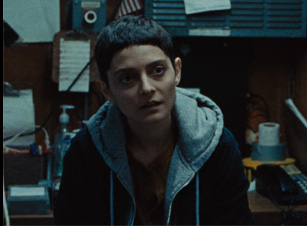Frankie (Ariella Mastroianni) can’t be entirely sure of what she’s seeing, standing across the street from an apartment building in “Gazer” where she might be a witness to a domestic dispute. She can’t give over her full attention when she’s on the clock, pumping gas for others in New Jersey where full service remains the law of the land, but also as Mastroianni and Ryan J. Sloan’s bewitching thriller reveals, Frankie’s mind will wander due to a rare neurological disorder that confuses time, losing a bit of herself in the drama taking place across the way, but not exactly able to keep track of it herself when just as her eye drifts from window to window, she could be conflating a number of different scenarios that she’s seen only moments apart. That becomes a problem when Frankie seemingly finds herself swept up in an ugly family squabble, having all the time in the world to ruminate on what she believed to have happened to a woman she saw (Renee Gagner) when she’s let go from her job at the Sunoco and enlisted by her to retrieve some items from her place without her brother (Jack Alberts), who appeared as if he attacked her, knowing nothing about it.
Frankie’s vision may be muddled, but Mastroianni and Sloan’s is pristine and unwavering in their unnerving first feature, pitched like a paranoid thriller from the 1970s with its long, languorous scenes and the idle, mischievous saxophone that comes in early to set the mood, but defiantly resists any effort to pin it to a particular era or genre otherwise. True to Steve Matthew Carter’s chameleonic score that seamlessly moves from blues to electronica, Frankie is thrust into a pulse-pounding web of intrigue after largely disengaging rom the world, following the death of her partner and the resulting custody battle over her daughter, who is in the custody of her partner’s mother when she was considered an unfit parent herself due to her condition. An opportunity to help the abused woman she meets at a survivor’s meeting becomes a potentially lucrative one for herself when sneaking into her apartment to get her things could help pay for charges related to getting her daughter back, but it also threatens to bury her when all is not as it seems and the danger she faces in looking any deeper triggers a recurring nightmare she have trouble awakening from in the rare moments she has to rest.
“Gazer” was a surprise for many reasons when it showed up at last year’s Cannes Directors Fortnight, a rare American film on the Croisette with two filmmakers that had few other credits, with Mastroianni having more as an actress. But the success the film has had on the festival circuit hasn’t caught the crew behind it off-guard when Sloan, Mastroianni and a small crew dedicated themselves to a two-and-a-half yearlong production in Newark to make the film they wanted to make without compromise – filming on celluloid, leaning into more idiosyncratic narrative choices and having no one but themselves to answer to when they relied on time rather than money to accomplish the seemingly impossible. The marvelous end result leaves an audience admiring how the people on both sides of the camera made it through such treacherous terrain and with the film beginning its theatrical run this week, beginning in New York before a national rollout, Mastroianni and Sloan spoke about how they seized on such a slippery mental malady to build their formidable debut on, the strong foundation of what time and locations they knew they had and seeing something they made now out in the world against all odds.

Ryan J. Sloan: We started writing this during the pandemic and we were revisiting a lot of the films that we loved — “Chinatown,” ”The Conversation…”
Ariella Mastroianni: “Vertigo.”
Ryan J. Sloan: “Burning,” Carol Reed’s “The Third Man,” all these great films, and we’re like, “This is the kind of movie we want to make. Now’s the time. Everything is kind of shut down. Ariella got furloughed from her job. I’m still working, but we need to buckle down and make a movie.” And we want to make this very intricate, layered mystery thriller.”
And Ariella was reading an Oliver Sacks novel [“The Man Who Mistook His Wife for a Hat”]. She got interested in whether or not there was a disorder relating to time, and she found dyschronometria, which is a real condition. Immediately, we hit the ground running [with the script] and we pretty much just had a wall filled with sticky notes and a blackboard with things written out. We had to plan out — similar to what Graham Greene, the writer of “The Third Man” did — where everybody was when they were offscreen because there’s a lot that happens offscreen, long before the main character [in “The Third Man”] even gets to Vienna. So we did the same thing with every single character in our film. We mapped out where everybody was at every point in time and where they were intersecting, what big plot points offscreen were happening when they happened, and that was our guiding light to keep us really tight while making the movie because we’re shooting over two-and-a-half years on weekends in April and November. It’s easier to get lost, [especially when] we’re shooting in a location, but we have the location for one day, andAriella is changing in and out of three different wardrobes [to match different parts of the film for the character]. So the question of “Hey, where am I coming from right now?” is very important. Mapping it out in that way really helped us.
You’ve got so many great locations in this, like that factory. Did you actually build the script around them?
Ryan J. Sloan: They’re real places in the town that I grew up in. The factory in particular isn’t there anymore and that’s why we wanted to shoot in my town. We wanted to try to capture everything before it was gone, because it’s being gentrified, like so many other places around the world. Yet my electrical company is right across the street from that factory and the woman who owns the place, her name is Mickey, she was really kind and sweet and generous and allowed us to shoot in there. It’s actually really funny because nobody knows how movies work in these places, so in the audio, you can hear her talking really loud, like, “So what are they doing right now? “How long are they going to be in?” I’m like, “We’re rolling camera.”
Ariella Mastroianni: But a lot of the locations came from customers of Ryan’s and family and friends. We wrote with these places in mind and used what was available to us.
Ryan J. Sloan: It was a grassroots community effort.

Ariella Mastroianni: It’s an interesting experience because as a writer, you try to capture every detail of the world and of the character as you see it. And I almost thought that my acting work was done within the writing process, but then I happily discovered that you have so much detail on the page, but then the acting process remains the same. You still have to fill in the embodiment of the character. So even though I thought I knew everything there was to know about Frankie, there was still so much to discover. That was such a surprise to me when we finally were taking it off the page and filling her in, filling out her voice, filling out her physicality, all of the kind of this space between the lines, you still have to fill in as an actor. It gave me even more reverence for both processes.
This two-and-a-half year production period is quickly gaining notoriety and of course, that seems difficult to hold onto a crew an an idea for that long, but were there benefits to it, like things you had the time to reconsider while you were making it?
Ryan J. Sloan: Yeah, we had set a hard date of shooting on April 2021 and we shot the beginning of the movie, then the end of the movie [in the same shoot]. Then over the summer, while we were waiting to get the film processed back and forth, I made a comment to Ariella, we were hanging out, and I [said], “Man, we’ve got to make a movie one day about a body in the trunk of a car in the Meadowlands.” And Ariella goes, “We should put that in ‘Gazer.'”
Things like that did happen. And it’s funny, I don’t think we ever lost hope. We knew that the movie was going to get done. What sucked the most was probably just getting our balls broke by our family and friends, where people are just like, “You’re still doing that thing?” Or “What’s taking so long?” And it’s like, “You guys just don’t understand. It costs a lot of money to do this, and if we make a mistake, we pay for it.
Ariella Mastroianni: But it was an investment.
Ryan J. Sloan: And we got to make the movie we wanted to see.
Ariella Mastroianni: Yes, I can’t think of any other place I would rather be putting my own money and time. It was a grueling process, but what else would we spend our money on? Like vacation or going out? We love this, so I really couldn’t conceive of doing anything else.

Ariella Mastroianni: I think we felt that every weekend.
Ryan J. Sloan: Every time we got the film back — because sometimes it would take months to get the film back because we didn’t have the money to pay for [the processing of] it and that time was very stressful because so many things can go wrong — but shooting on film, it’s magic. There’s light coming in and hitting celluloid, and there’s the chemicals reacting, and it’s a magical thing.
Ariella Mastroianni: The first couple of shoots, we didn’t have a VTAP [that allows watching playback on scenes].
Ryan J. Sloan: Yeah, so there could be something wrong. But with Kodak, there could be something wrong in the bath. There’s a million things that could go wrong in between that time. So when we got the footage back, we were always very relieved, but then get very excited because we worked hard to make sure that we were getting what we wanted. The whole film was storyboarded from beginning to end and we did a lot of rehearsals with the actors to make sure that we were making the movie we wanted to see.
Ariella Mastroianni: And we were very lucky — and intentional — with who we surrounded ourself with because our whole team, which was a very small team, were all making the same project, and we were all very excited by the project. That’s helpful to arrive on a set where everyone is excited by what you’re doing, and it’s not just a job. It was hard to go into these weekends fresh, but what was fun is that we were, by the end of it, we just wish we had time to continue and the people really made it the most fun.

Ryan J. Sloan: Honestly, it was a dream come true. Steve [Matthew Carter, the composer] is one of my best friends and just one of my life collaborators, if you will. We’ve been making music together for 15, 20 years, and he’s just such a great human. When Ariella and I were talking about “Gazer,” I would call him up and just very excitedly tell him what we were exploring and what we were looking for and he just started writing right away. We were fortunate enough to go into production with these 10 tracks, most of which I don’t think ended up in the film, but it was the energy and it was the vibe of the film and he really set that tone that first time through.
It wasn’t until about halfway through shooting when he hired a friend of his named Harrison to come in and play the sax and that’s when that motif came in. As soon as I heard that, I thought “This is the main theme of the film.” Then Steve started writing everything around that main theme. He did this really genius thing of having it start very organically, mirroring Frankie’s psyche at that point in the film, and then having it deteriorate sonically as Frankie continues on this journey, created by using electronic music, synthesizers and so on that were very chopped up and diced up.
Ariella Mastroianni: Yeah, it was so reflective of the whole dichotomy of Frankie forced to live an analog life in today’s digital world. He really captured that musically and it also was very helpful for us on set as well. [Playing the music on set] was one of the things that really anchored us in tonally in making this film.
Ryan J. Sloan: The best part is when I shared that main theme with people, before they saw it attached to the picture where it was gonna be in the picture, I got laughed at by half our crew. Everybody was like, “Oh, that’s a choice.” And I’m like, “Yeah, it’s fucking perfect.”
Ariella Mastroianni: It gave us the world. Because you’re shooting something over two-and-a-half years. How do you keep that consistent? That was one of those things.

Ryan J. Sloan: It’s been a fever dream. I can’t believe the movie’s coming out finally, and I don’t even know what I’m going to do. We’re writing the new thing — and we tease it in “Gazer” — and we’re very excited about all those things, but it feels surreal and a little bittersweet. It’s five years. It’s like sending your kid off to college in a way and he or she is no longer ours.
Ariella Mastroianni: Yeah, this whole journey has been staying true to the things that feel the most honest. We made this film for no other reason than because it was a film that we really, really wanted to capture and wanted to see. We really missed this type of filmmaking. But we didn’t do it for any other reason. Even when we were talking to partners in terms of distribution, the theatrical experience was very important to us. So every step of this process, we just stayed really true to…
Ryan J. Sloan: …the things that we believe.
Ariella Mastroianni: The things that we believe and the things that we love, which at this point is the last phase, which is presenting it in theaters for people to see.
“Gazer” opens on April 4th in New York at the Angelika Film Center and April 11th in Los Angeles at the Alamo Drafthouse DTLA.




